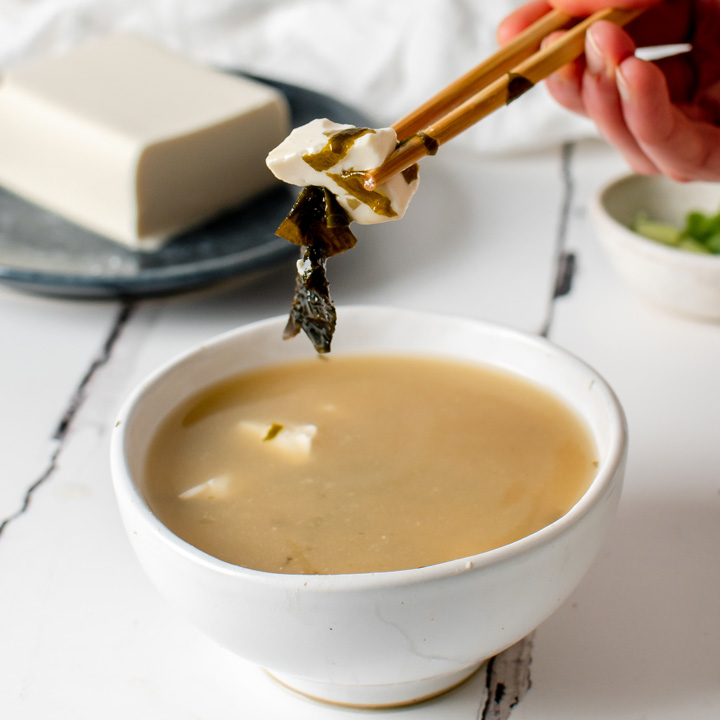Could the secret behind the Japanese population’s long life expectancy lie within their diet?
(1,2,3). Washoku is the Japanese phrase for ‘traditional Japanese cuisine’, and is prised for its use of simple, fresh, seasonal, healthy dishes which are full of flavour. Comprising of mostly plant-based ingredients and fish, and only moderate amounts of foods more commonly found in a Western diet such as meat and dairy (4). This dietary pattern may play a role in supporting overall health, which is likely to underpin the longevity of the Japanese population.
Here are five health-promoting principles of the Japanese cuisine…
1. Plenty of plant-based foods and seasonal ingredients
The Japanese cuisine encompasses a wide variety of plant-based dishes. A traditional Japanese diet has a focus on seasonality and locally sourced veggies. From daikon radishes to carrots, sweet potatoes, cabbage, spring onion, cucumber, sweet corn, mushrooms, ginger, and Kabocha (pumpkin) which are just to name a few. When out-of-season preserved foods are enjoyed. These may have been fermented such as natto (fermented soybeans) or pickled such as Tsukemono (pickled vegetables). Did you know that fermented foods are a source of beneficial bacteria which may support the health of our gut?
Rice and noodles including udon (wheat) and soba (buckwheat) are key plant-based stables of Japanese dishes. They’re often enjoyed in the form of sushi, donburi (rice bowls), ramen (a broth) or yakisoba (stir-fried). The abundance of plant-based foods within the Japanese diet, along with nourishing cooking methods is an excellent way to increase intakes of fibre, vitamins, minerals and health-promoting antioxidants.
2. Lean protein with unique health benefits
A major source of protein in the Japanese diet comes from soya beans, which are enjoyed in a wide variety of forms. From edamame beans and tofu to their fermented counterparts such as tempeh, natto and miso. Soya is an excellent source of high-quality plant protein yet unlike meat is low in fat and saturated fat. It’s a source of fibre, and nutrients such as magnesium, iron, and even calcium. Soya is unique as it provides a high concentration of phytoestrogens called isoflavones. Phytoestrogens are plant compounds which exert weak oestrogenic effects within the body and are thought to be responsible for some of soya’s health-promoting attributes. Soya’s excellent nutrition profile is likely to be why consumption is associated with a reduced risk of heart disease, hot flushes accompanying menopause (5,6), and possible protective effects on prostate and breast cancer risk (7,8,9). The average consumption of soy isoflavones for Japanese adults is 30-40 mg/d, yet in Europe this is less than 3 mg/d (10,11,12,13). To put this into perspective, 250ml soy milk or 100g of tofu provides on average 25 mg of isoflavones, which indicates the Japanese population consume at least 1-2 portions of soya daily (14).
3. An abundance of fish and an array of sea vegetables
Fish is a nutrient-dense staple of the Japanese cuisine. Oily fish is a rich source of omega-3 fats which are essential within the diet to support the health of our brain, heart and vision (15). Fish also provides high-quality protein, yet is low in saturated fats. It’s commonplace within Japanese cuisine to enjoy raw fish as sashimi, which is a healthy low-fat way to prepare a dish. The Japanese diet also includes an array of seaweeds, providing minerals such as iodine which supports thyroid health and cognitive function (15).
4. A wealth of green teas
Green tea is a popular and highly consumed beverage in Japan which can be enjoyed in various forms. For example, Sencha tea is Japan’s most commonly consumed green tea and is prepared by steeping the tea leaves in warm water, then enjoyed as a refreshing beverage. On the other hand, matcha green tea uses the dried whole tea leaf which is milled into a powder. Instead of steeping this tea, the powder is combined with water or milk. Not only is green tea an excellent source of health-promoting antioxidants, but is also rich in a component called l-theanine which may provide feelings of relaxed alertness and clarity (16).
5. Healthy cooking methods and mindful eating
The traditional approach to the Japanese cuisine includes strong elements of mindful eating. ‘Hara Hachi Bu’ translates to ‘eat until you are 80% full’. This mindful way of eating can be a useful tool to better recognise our hunger and fullness cues which aids with weight management. It therefore may come as no surprise that the Japanese have very low rates of obesity, with less than 4% of the population classified as obese (17). Furthermore, healthy cooking methods used in the traditional Japanese cuisine such as steaming, boiling and stewing not only uses less fat but can increase the water content of that meal which may be beneficial for weight management (18). Other common cooking methods include grilling, pickling and stir-frying all of which use oil sparingly.
Following the principles of the traditional Japanese cuisine at home has never been easier with Panasonic Kitchen appliances. In fact, each appliance has been developed with these dietary principles in mind, allowing us to create those fresh, healthful and flavoursome dishes. For example, Panasonic’s Steam Combi Oven is an excellent low-fat way to prepare Japanese-inspired recipes, why not try this japanese steamed tofu with ponzu or grilled salmon and tomatoes in dashi broth?
References:
1.https://www.macrotrends.net/countries/JPN/japan/life-expectancy
2.https://www.nature.com/articles/s41430-020-0677-5
3.https://www.ncbi.nlm.nih.gov/pmc/articles/PMC8189904/
4.https://www.ncbi.nlm.nih.gov/pmc/articles/PMC5852749/
5.https://pubmed.ncbi.nlm.nih.gov/22433977/
6.https://pubmed.ncbi.nlm.nih.gov/15333734/
7.https://pubmed.ncbi.nlm.nih.gov/27886135/
8.https://www.bda.uk.com/resource/soya-foods.html
9.https://pubmed.ncbi.nlm.nih.gov/29300347/
10.https://pubmed.ncbi.nlm.nih.gov/16965235/
11.https://pubmed.ncbi.nlm.nih.gov/31079144/
12.https://pubmed.ncbi.nlm.nih.gov/24020353/
13.https://pubmed.ncbi.nlm.nih.gov/22510793/
14.https://pubmed.ncbi.nlm.nih.gov/16965235/
15.https://www.gov.uk/government/publications/great-britain-nutrition-and-health-claims-nhc-register
16.https://www.ncbi.nlm.nih.gov/pmc/articles/PMC6836118/
17.https://www.nibiohn.go.jp/eiken/kenkounippon21/download_files/other/document_en_02.pdf
18.https://pubmed.ncbi.nlm.nih.gov/10500012/
























